![]()
Coreform Cubit 2025.8 User Documentation
![]()
Sculpt options for specifying adaptive meshing. Sculpt uses an initial overlay Cartesian grid that serves as the basis for the all-hex mesh. The default mesh size will roughly follow the constant size cells of the overlay grid. The adaptivity option allows the user to automatically split cells of the Cartesian grid based on geometric criteria, resulting in smaller cells in regions with finer details. The adapted grid is then used as the basis for the Sculpt procedure.
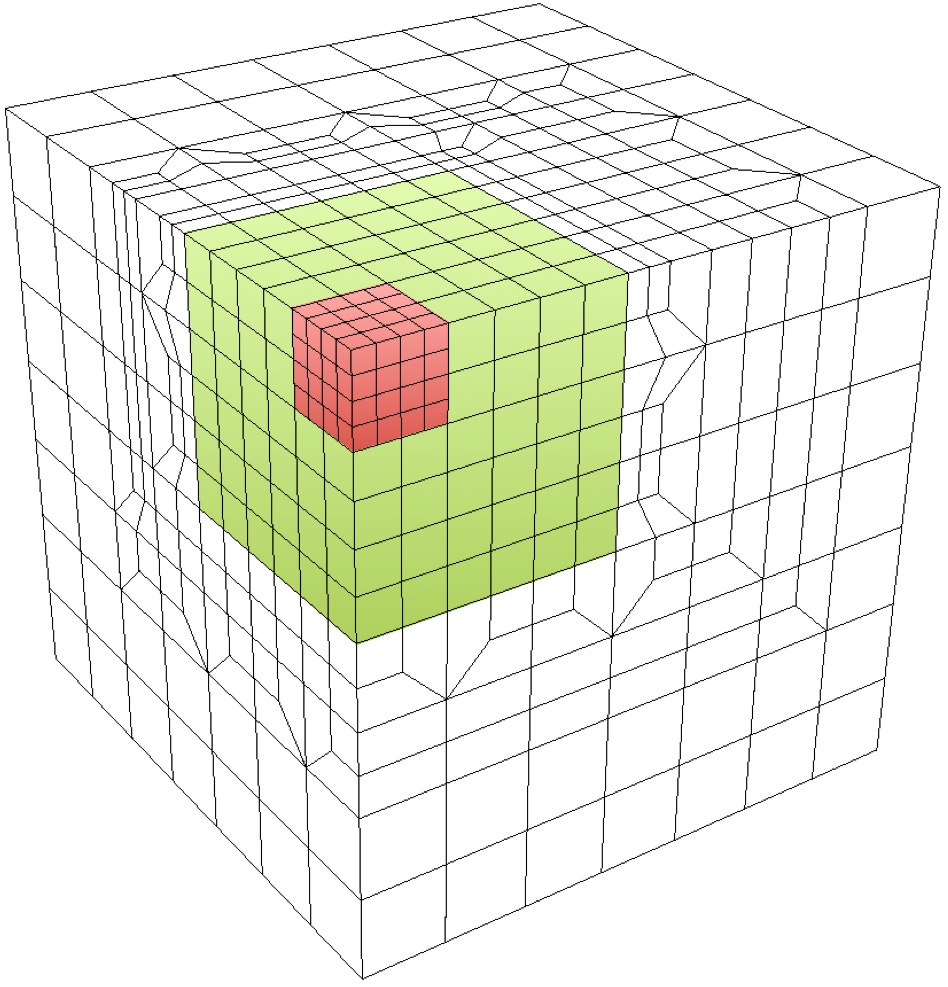
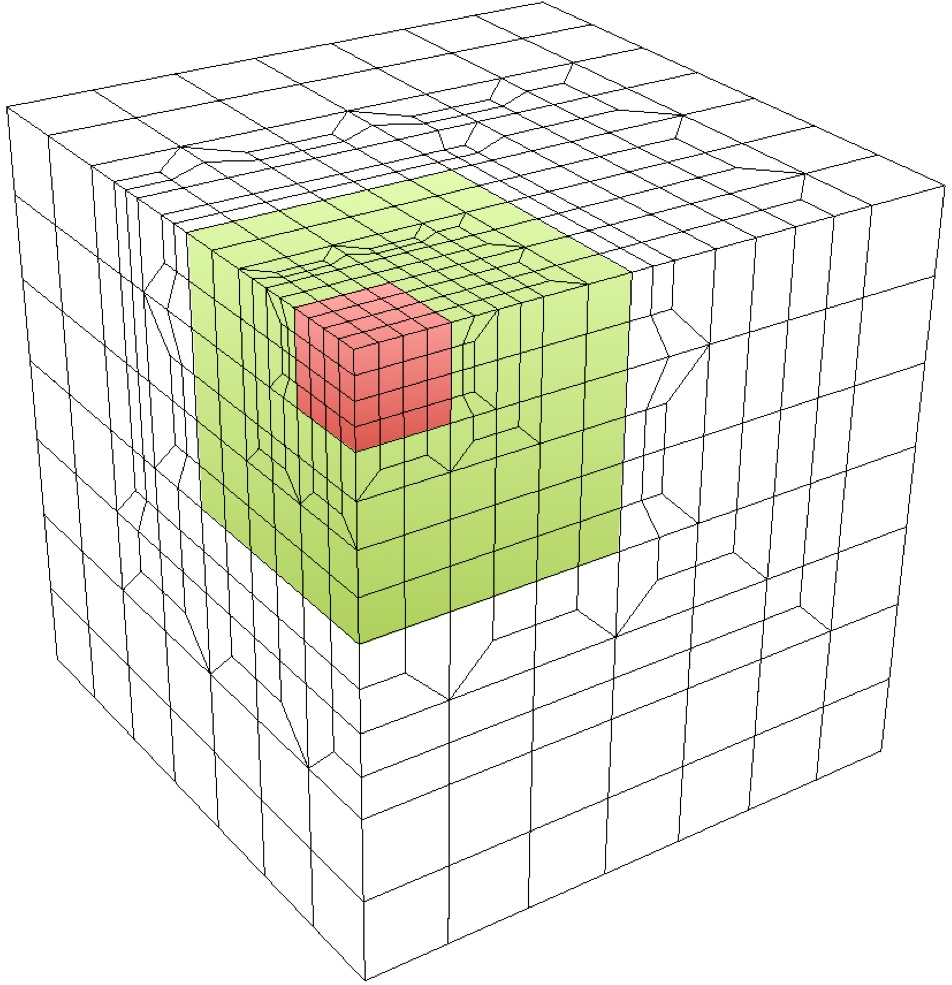
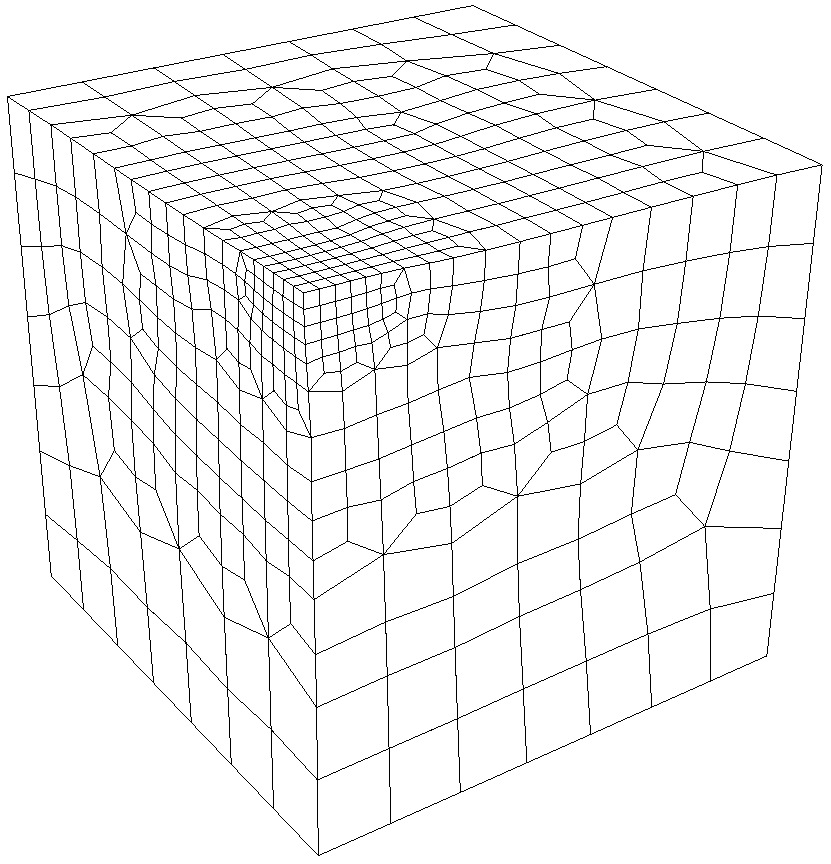
Adaptive mesh begins with constant size coarse Cartesian grid. Cells are recursively split based on geometry criteria and transitions added between levels. Projections and smoothing are performed to improve element quality.
Three options are used for controlling the adaptivity in sculpt: adapt_type, adapt_levels and adapt_threshold. The adapt_type option controls the method and geometric criteria used for deciding which cells to split in the grid, while the adapt_levels option controls the the maximum number of times any one cell can be split. Depending upon the adapt_type selected, the adapt_threshold is used as the specific geometric threshold value at which the decision is made to split any given cell.
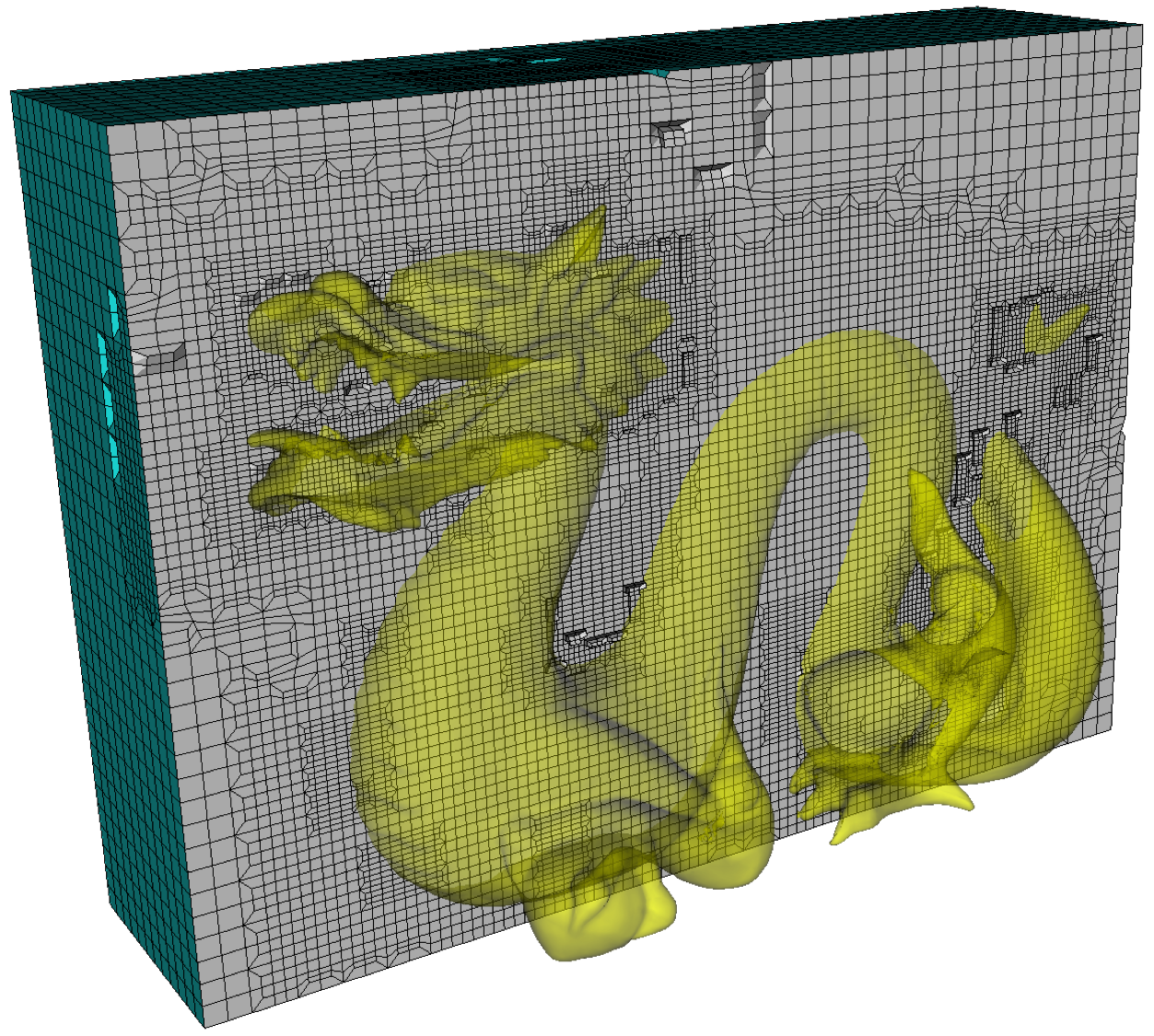
Initial cut-away view of adapted grid from dragon model before performing Sculpt operations.
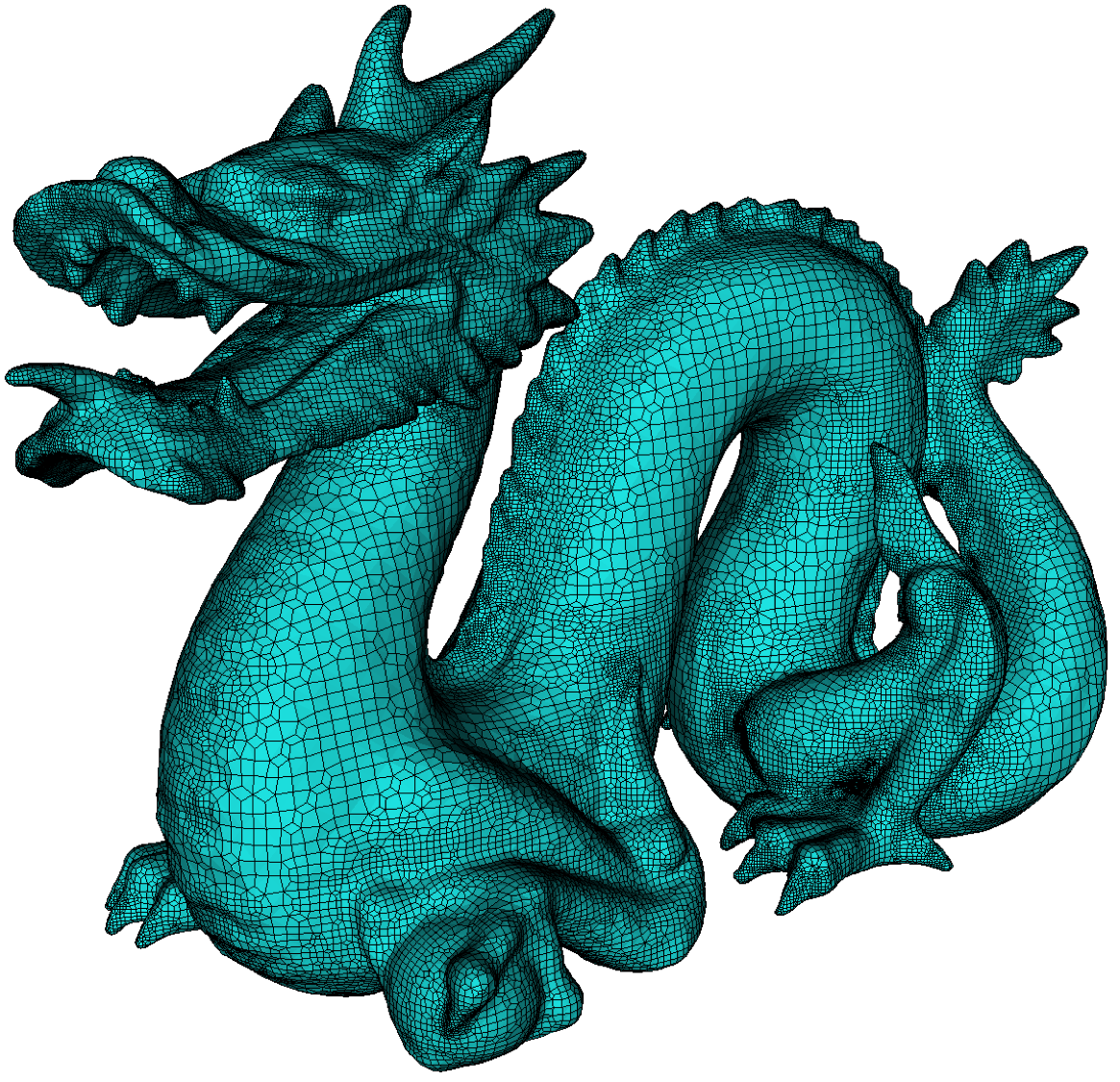
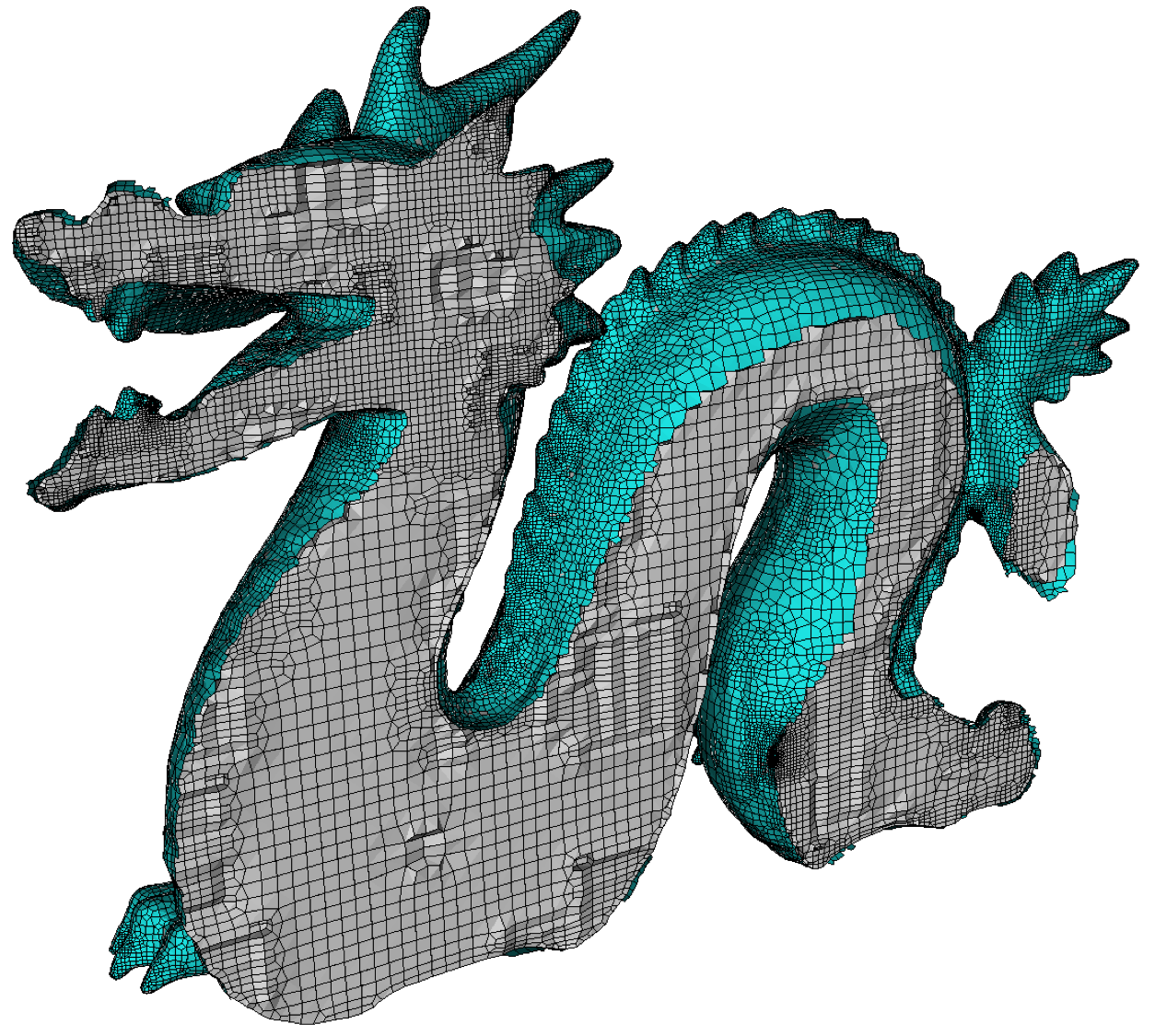
The final mesh of the dragon model and cutaway view of the mesh is shown with up to 4 levels of adaptive refinement.
Adaptive Meshing -adp --adapt --adapt_type -A <arg> Adaptive meshing type --adapt_threshold -AT <arg> Threshold for adaptive meshing --adapt_levels -AL <arg> Number of levels of adaptive refinement --adapt_material -AM <arg> Info for adapting material --adapt_export -AE Export exodus mesh of refined grid --adapt_non_manifold -ANM Refine at non-manifold conditions --adapt_load_balance -ALB Adaptive parallel load balancing --adapt_memory_stats -AMS Write memory usage stats for adaptivity Sculpt Command Summary
Command: adapt_type Adaptive meshing type Input file command: adapt_type <arg> Command line options: -A <arg> Argument Type: integer (0, 1, 2,...7) Input arguments: off (0) facet_to_surface (1) surface_to_facet (2) surface_to_surface (3) vfrac_average (4) coarsen (5) vfrac_diff (6) vfrac_difference (6) resample (7) material (8) region (12)Command Description:
This option will automatically refine the mesh according to a user-defined criteria. Without this option, a constant cell size will be assumed everywhere in the model. To build the mesh, Sculpt uses an approximation to the exact geometry of the CAD model by interpolating mesh surfaces from volume fraction samples in each cell of the Cartesian grid. In general, the, higher the resolution of the Cartesian grid, the more sampling is done and the more accurate the mesh will represent the initial geometry. The adapt_type selected will control the criteria used for refining the mesh. If the criteria is not satisfied, the refinement will continue until a threshold indicated by the adapt_threshold parameter is satisfied everywhere, or the maximum number of levels (adapt_levels) is reached. The following criteria for refinement are available:

Distance from STL Facet to Approximated Geometry. The distance d is measured between the facets (green) where they cross the edges of the grid, to the closest point on the interpolated geometry. If d > adapt_threshold then the cell is split.
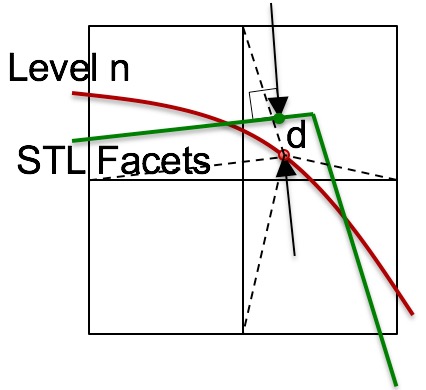
Distance from Approximated Geometry to STL Facet. The distance d is measured between points on the interpolated geometry corresponding to a projected point on the grid, to its closest point on one of the STL facets. If d > adapt_threshold then the cell is split.
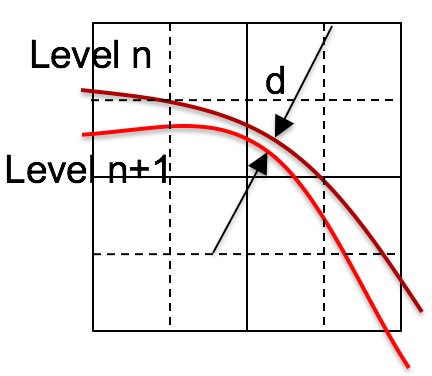
Distance Between Child and Parent Approximated Geometry. After computing the interpolated geometry for level n and level n+1, d is the distance between the two geometry representations. Cells where d > adapt_threshold are split.
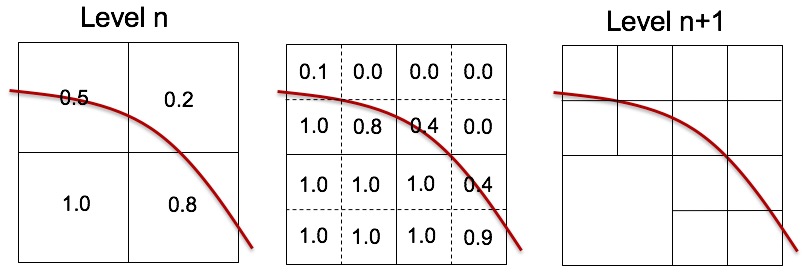
Difference of Cell Volume Fraction. Volume fractions are evaluated for the 8 child cells of a cell at level n. This example shows where one or more of the volume fractions at level n+1 of the lower left cells does not differ by more than a threshold d, so it remains unsplit.



Refine to Dense Data (Coarsening). Initial grid at resolution N X M is coarsened to N0 X M0 based on the adapt_levels value. Coarse cells are then split similar to criteria in adapt_type = 4.
To maintain a conforming mesh, transition elements will be inserted to transition between smaller and larger element sizes. Default for the adapt_type option is off (0) (or that no adaptive refinement will take place).
In all cases the initial Cartesian grid defined by xint, yint and zint or the cell_size value will be used as the basis for refinement and will define the approximate largest element size in the mesh.
Command: adapt_threshold Threshold for adaptive meshing Input file command: adapt_threshold <arg> Command line options: -AT <arg> Argument Type: floating point value >= 0.0Command Description:
This value controls the sensitivity of of the adaptivity. The value used should be based upon the adapt_type:
facet_to_surface (1)
surface_to_facet (2)
surface_to_surface (3)
For these options, the adapt_type selected represents an absolute distance between surfaces or facets. Where the distance exceeds adapt_threshold the nearby cell or cells will be identified for refinement. The smaller this number the more sensitive will be the adaptation and greater the resulting number of elements. If not specified, the adapt_threshold will be determined as follows:
adapt_threshold = 0.25 * cell_size / adapt_levels^2
vfrac_average (4)
coarsen (5)
The adapt_threshold value in this case represents the maximum difference in volume fraction between a parent cell and the average of its eight child cells. This value should be between 0.0 and 1.0. The smaller the number, the more sensitive will be the adaptation and the greater the number of resulting elements. A default adapt_threshold of 0.01 is used if not specified.
Refinement occurs if volume fraction of material in a cell exceeds the threshold value. A separate threshold can also be set for each adapt_material overriding the the global value for threshold.
Note that the user defined adapt_threshold may not be satisfied everywhere in the mesh if the value defined for adapt_levels is exceeded.
Command: adapt_levels Number of levels of adaptive refinement Input file command: adapt_levels <arg> Command line options: -AL <arg> Argument Type: integer >= 0Command Description:
The maximum number of levels of adaptive refinement to be performed. One level of refinement will split each Cartesian grid cell identified for uniform refinement into eight child cells. Two levels of refinement will split each cell again into eight, resulting in sixty-four child cells, three levels into 256, and so on. The maximum number of subdivision per cell is give as:
number of cells = 8^adapt_levels
The minimum edge length for any cell will be given by:
min cell edge length = cell_size / adapt_levels^2
The actual number of refinement levels used will be determined by whether all cells meet the adapt_threshold, or the adapt_levels value is exceeded. The default adapt_levels is 2. Note that setting the adapt_levels more than 4 or 5 can result in long compute times.
Command: adapt_material Info for adapting material Input file command: adapt_material <arg> Command line options: -AM <arg> Argument Type: 5 optional valuesCommand Description:
Specifies material information to be used with the adapt_type = material option. This option expects up to 5 ordered values representing the following:
This option may be used multiple times in the same input, once per material to be adapted.
Command: adapt_export Export exodus mesh of refined grid Input file command: adapt_export Command line options: -AECommand Description:
Export an exodus mesh containing the refined Cartesian grid. Interface reconstruction, boundary layer insertion and smoothing have not yet been applied to this mesh. It is the base mesh used as input to Sculpt. One file per processor will be exported in the form "vfrac_adapt.e.x.x". The exodus mesh produced will also contain the computed volume fractions for each material present in the model represented as element variables.
This option is primarily used for debugging the refinement option. However the mesh produced with this option can be used as the base mesh when used with the input_mesh option. For example, instead of Cartesian grid options, the input mesh may be specified as input_mesh = vfrac_adapt.e.1.0. Sculpt will use the refined mesh and the volume fraction element variables to build the final mesh.
Command: adapt_non_manifold Refine at non-manifold conditions Input file command: adapt_non_manifold Command line options: -ANMCommand Description:
If refinement results in a non-manifold condition at a node, the surrounding cells will be identified for refinement. In some cases, using this option will result in a closer match to geometry for thin layers or small features. Using this option will normally result in more elements at material interfaces. Note that in all cases non-manifold conditions will be resolved even without this option in a subsequent step, however without this option, the resulting solution may not match geometry as accurately.
The adapt_non_manifold option is off by default. It is currently only implemented for adapt_type that use an STL geometry definition. (adapt_type = 1,2,3)
Command: adapt_load_balance Adaptive parallel load balancing Input file command: adapt_load_balance Command line options: -ALBCommand Description:
Do adaptive load balancing during refinement. Uses Zoltan's Recursive Coordinate Bisection (RCB) algorithm to repartition parallel domains following each adaptive level.
Default (OFF), refinement, will use roughly spatially equal volume domains on each processor. This can cause significant imbalance in work between processors, sometimes causing failure, especially where adpativity is localized. When using adapt_load_balance, Sculpt will repartition the parallel domains after each adaptivity level so that each processor maintains approximetly equal numbers of elements to equalize work and memory among processors.
Command: adapt_memory_stats Write memory usage stats for adaptivity Input file command: adapt_memory_stats Command line options: -AMSCommand Description:
When the adapt_type option is enabled, it allows users to monitor the memory usage and availability during the adaptivity procedures. By setting this option, both minimum and maximum memory usage for the current processor arrangement will be recorded. This information can be particularly useful when building meshes with many levels of refinement or when there are significant variations in the spatial distribution of refinement regions.